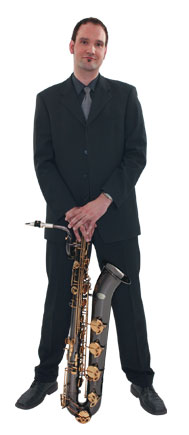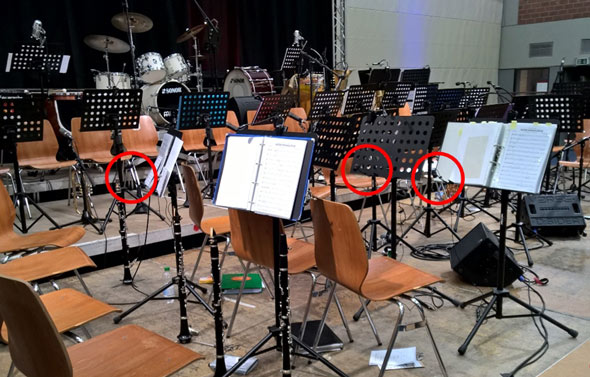Sound Engineering for Hornsor: "A Mixing Console is Not A Treatment Plant"
In the life of your regular brass band, sound reinforcement, or rather event equipment comprising microphones, a mixing console, amplifiers and speakers, is not a prominent consideration. During rehearsals without a singer who might need to be amplified, no sound reinforcement is used. In big bands that include electric guitars, an electric bass and/or keyboards, the musicians in question usually use their own rig.
Yet, for bigger concerts, at least one person should think about sound reinforcement: do we need it? What exactly would we need? Does somebody already have equipment we could use or should we contact an external rental company and/or sound engineer? Sound reinforcement is a delicate matter, and most of us know very little about it. In this workshop, I would like to share my experience gathered over the years. I shall discuss the purpose and applications of a sound system and provide a few hints for musicians who are interested in sound reinforcement.
Why on earth...
would anybody need sound reinforcement? The subject is closely related to the audience’s and our own expectations: "By miking up all instruments, we can create a big sound. We could even record a multi-track version of our performance and release a new CD." As for the detractors: "We are already loud enough as it is! We don’t need speaker cabinets or microphones. Back in the old days, nobody used a PA system. It only creates more work and it costs a fortune. Besides, it only makes things more complicated. As for me, I don’t want a microphone, because that would mean that everybody can hear me."
The first step should be to analyze the benefits of a sound reinforcement system. There are several likely scenarios:
1. Scenario
The orchestra has a balanced sound, all parts and registers are well staffed and master their instruments. A conductor, or the musical director, guides and controls the dynamics and artistic aspects of the performance. From an acoustic point of view, i. e. even without any technological aids, the overall sound is already impressive.
This is the ideal situation, usually only achieved by professional bands. In a venue with suitable acoustics, sound reinforcement is often unnecessary and may even degrade the sound quality.
If, however, the venue provides less-than-perfect acoustic conditions, sound reinforcement quickly becomes a must. Just think of open-air events at "event locations" that are not suited for music performances, or mega events where the distance between the audience and the orchestra needs to be bridged in one way or another.
The great concert
A practical example for our band is the annual performance at the local multi-purpose hall: the band sounds rather good, yet from the 10th row onward, the sound tends to become "muddy" and lacks definition. This is due to two acoustic phenomena:
1. since the direct sound coming from the orchestra is combined with the venue’s reflections, the sound increasingly lacks definition because of the increasing delay between the direct signal and the reverberation;
2. the range of sounds depends on their frequency: lower frequencies travel longer distances than high frequencies. This causes a shift and degradation of the sonic image. A timbale is still
clearly audible at the back of the hall, while the clarinet solo may go by unnoticed.
Typical scenario: Concert at the local multi-purpose hall. A small speaker setup for the audience and monitor speakers for the solo vocalists and the orchestra on stage.
Miking up and amplifying the orchestra allows you to lift the wanted signal above the venue’s sound"”at least within the range covered by the PA system.
Ideally, this only requires you to amplify the orchestra’s original sound. This can be achieved by either using a stereo pair of microphones or by placing microphones in front of all instruments.
2. Scenario
Unfortunately, not all sections are sufficiently manned, and some players tend to substantially vary their "output power".
In such a situation, microphones can help to reinforce underrepresented sections, thereby creating a more homogeneous sound. This would allow to give understaffed or "soft" sections more prominence with respect to the remaining, louder, sections.
In a typical big band with a saxophone section comprising two tenor saxes, two alto saxes and one baritone, the baritone can benefit from a separate microphone, because the baritone part is usually as important as the other parts of the sax section. Bear in mind that the baritone also needs to cut through the trumpets and trombones... Furthermore, even though the baritone sax looks rather big, it has a difficult range and therefore often seems softer than the tenor or alto saxes. The latter two could each share one microphone and additionally take advantage of it for their occasional solos.
As far as trumpets and trombones are concerned, loudness is usually not an issue. Expert use of microphones and clever EQ settings may, however, create a denser sound and help the horns "shine." And let’s not forget trumpet solos played with a mute: a microphone often provides welcome support for the soloist.
Examples of Microphone Placements and Types:
For clarinets: Clip-on microphones (small diaphragm condensers) attached to the music stands and all but invisible (example: Audio Technica Pro 35)
Large-diaphragm condenser microphones: discreetly placed among the saxophones (example: Audio Technica AE 3000)Dynamic microphones for brass (left to right): Examples: EV N/D 308 for trombones, and EV RE 320, EV PL 10 among the trumpets and flugelhorns. Surprisingly enough, the Audio Technica Pro 35 clip-on microphone also beautifully renders a tuba.
3. Scenario
Monitoring for musicians Sound reinforcement is not necessarily only a godsend for the audience. The musicians on stage also benefit from monitor speakers: they allow them to hear themselves and the other instruments.
A rather common example: For space and stage-layout reasons, the trumpets all but blow directly into the clarinet players’ ears. If one of them asks them to play a little softer, the reply is invariably: "If we do that, we can’t hear ourselves...". The trombones can’t hear themselves either, because the drums are too loud. And their intonation already suffers from the poor sound on stage.
Placing a few monitor speakers in strategic positions will work wonders here. Such speakers allow to prepare mixes that are not related to what the audience hears: in some cases, only one instrument is heard, while other monitors may feed the sound of the entire orchestra.
Unlike microphone inputs used to receive signals, monitor channels are output/Send channels, i.e. signals transmitted to speakers (just like the console’s master outputs that feed the front-of-house speakers). A mixing console is used to manage all incoming and outgoing signals. This signal
management is usually performed by a sound engineer.
The sound engineer’s console should ideally be located at the center between the front-of-house (FOH) speakers and form an equilateral triangle with them. ( -in this case, he may be a little far from the stage).
The sound engineer has the most important role: he is in charge of preparing a balanced mix for the audience and of providing the musicians with the sonic information they require. To make this work, the sound engineer needs to be aware of the orchestra’s preferred sound, of its repertoire"”and he needs to be familiar with the pitfalls and specificities of miking up various instruments.
Well, there’s some food for thought...
Jürgen Wieching







